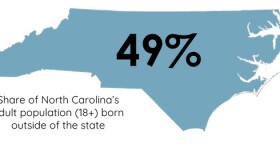Wake County's population grew by 68 people per day last year.
That's according to the latest U.S. Census figures.
Taken as a whole, North Carolina showed robust population growth in 2016, but once again, that growth was concentrated in only a few counties. Population growth in Wake and Mecklenburg accounted for 40 percent of overall growth.
Much of the growth happened in suburban areas around Raleigh and Charlotte. Rolesville, for example, saw a big percentage jump. So did towns like Apex, Fuqua-Varina and Youngsville.
Rebecca Tippett, director of Carolina Demography at UNC-Chapel Hill's Carolina Population Center, pointed to what she called "suburban overflow growth" driving growth. That includes growth in the unincorporated areas of counties. A still small – but growing – portion of the population is increasingly willing to live somewhat farther from city centers if it affords them more affordable housing or land. This has led to smaller community areas popping up in the more rural parts of counties that house big cities.
"That means those places are urbanizing in their own way," she said.
However, a full 34 counties saw their population decline in just one year. Robeson County saw the biggest exodus, losing more than 1,000 off its population, a measure taken during the summer, meaning any losses from Hurricane Matthew are not yet included.
Below is an interactive graphic to see population trends in North Carolina from 2010 to 2016. As the chart depicts, much of the population growth has been concentrated in Wake and Mecklenburg counties. Scroll a cursor over the map to see percentage growth, or on each bar line to see total growth.








